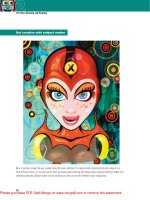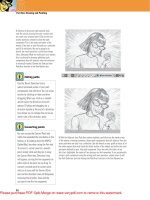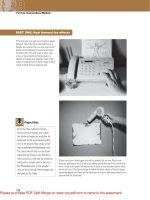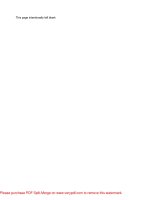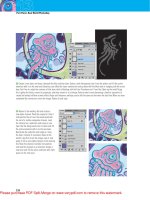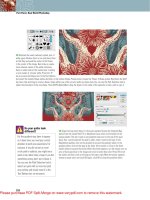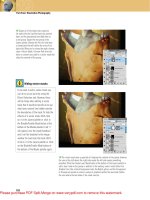creative photoshop digital illustration and art techniques - Phần 2 ppsx
Bạn đang xem bản rút gọn của tài liệu. Xem và tải ngay bản đầy đủ của tài liệu tại đây (12.78 MB, 38 trang )
22
Creative Photoshop
Part 1: Drawing and Painting
5 I In the tool options bar, select the ellipse shape tool and then disable the chain-
link button by clicking on it, so that the new color we choose from the swatch in
the tool options bar is not applied to the currently targeted shape layer. Click the
color swatch in the tool options bar and select a dirty yellow color from the picker.
Ensure that the create new shape layer option is enabled and then click and drag,
while holding down the shift key to create a perfectly circular shape layer. You can
reposition the entire shape layer with the move tool.
6 I Drag the shape layer onto the create a new layer button in the layers palette to
duplicate it. Target the original layer (the one beneath the copy) in the layers palette.
Choose EditϾFree-Transform from the menu and drag the corner points of the box
outwards to increase the size, and alter the shape of the shape layer. Press the enter key
to apply the transformation. In the tool options bar, enable the chain-link button to affect
the current layer. Then specify a black fill color via the swatch in the tool options bar.
Which tool do I use?
Using the move tool will allow you to move
an entire shape layer around on the canvas.
However, if you want to move your shapes
around within your layer, you’ll need to use
the path selection tool. Simply click on the
shape you wish to move and drag it with
the path selection tool. This is especially
useful when your shape layer contains
more than one shape and you wish to move
shapes independently of each other.
Ch02-K52046.indd 22Ch02-K52046.indd 22 6/21/07 5:29:40 PM6/21/07 5:29:40 PM
23
Creating Characters with Shape Layers
Chapter 2
7 I Target the top layer in the layers palette, so that your next layer will be created above it. Again, use the ellipse shape tool to draw a
smaller circle in his eye area. Ensure that the create new shape layer option is enabled as you create the circle. Next, change the fill
color of the new layer to red via the color swatch in the tool options bar. With this new layer targeted, choose the stroke effect from the
layer styles menu at the bottom of the layers palette. Add a darker red stroke to the outside of the circle.
Finish, group, duplicate and flip
Complete the eye area and add a cheek detail. Then flip the artwork to the
other side of his face.
1 I Use the same methods to create two new
shape layers. One containing a black pupil
shape, and another containing a purple
cheek shape. Target all of the eye and cheek
shape layers in the layers palette. Type
Control(PC)Command(Mac)-g to group them.
2 I Select the move tool and ensure that
your gr
oup is targeted. Hold down the
alt(PC)/option(Mac) and the shift key as
you drag the artwork to the right side of
his face, creating a duplicate of the group,
aligned horizontally.
3 I Choose EditϾT
ransformϾFlip
Horizontal from the menu to horizontally
flip your duplicated group. Expand the
duplicated group in the layers palette and
target the red iris layer. Shift-drag to the
right on the canvas with the move tool,
repeat this process with the duplicated
pupil shape layer. This will remedy his
cross-eyed appearance.
Ch02-K52046.indd 23Ch02-K52046.indd 23 6/21/07 5:29:50 PM6/21/07 5:29:50 PM
24
Creative Photoshop
Part 1: Drawing and Painting
Subtracting and combining shapes
Now we’ll explore how multiple shapes can be used together within a single shape layer, producing a nice nostril highlight at
the same time.
1 I Select the ellipse shape tool, and
select the cr
eate new shape layer
function in the tool options bar. Create
a light blue ellipse on the canvas, over
his nostril as a new shape layer. Use
the Path selection tool to reposition it
if necessary.
2 I Use the Path selection tool to drag
the shape to the r
ight and down a
little while holding down the alt(PC)/
option(Mac) key, duplicating it. With the
duplicate shape selected, click on the
subtract from shape area button in the
tool options bar.
3 I Click the combine button to create
a single shape
, resulting from the
subtract operation. Alt(PC)/Option(Mac)-
drag this shape to the right with the
Path Selection tool. Choose EditϾ
Transform PathϾFlip Horizontal from
the menu. Press Enter and adjust the
positioning of the flipped duplicate
shape if necessary.
8 I Collapse the group in the layers palette. Use the eyedropper tool to click on the dark blue area around his eye, sampling it as the
cur
rent foreground color. Use the Pen tool to create a new shape layer in the middle of his face. Carefully draw a nose shape with the
pen tool. Take your time, clicking once to create sharp points, clicking and dragging to create curved points. Edit the shape with the
direct selection tool wherever necessary. Next, select the ellipse shape tool and draw a lighter blue ellipse over his nose on a new
shape layer.
Ch02-K52046.indd 24Ch02-K52046.indd 24 6/21/07 5:30:00 PM6/21/07 5:30:00 PM
25
Creating Characters with Shape Layers
Chapter 2
9 I Set the foreground color to black. Select the pen tool
and ensure that the create new shape area option is
enabled. Draw a closed shape to indicate his mouth.
Click and drag to create a series of curved points and
use the direct selection tool to edit your points and curves until the mouth shape is looking just
right. Duplicate the mouth shape layer in the layers palette so that there are now two of them.
Target the duplicate mouth layer and press the link button in the tool options bar, so that when
you change the color, this layer will be affected.
10 I Click the color swatch in the tool options bar. When the picker opens, move the mouse out over the yellow part of
the eye on the can
vas and then click to select this yellow as the fill color for this shape layer. Click OK and select the
pen tool. Choose the intersect shape areas option in the tool options bar and then draw a closed shape that contains
two fangs that overlap the mouth area. As you draw, you’ll see the layer content disappear and then only reappear in
areas where the new shape overlaps the existing shape within the current shape layer.
Switching to a selection tool
When you are working with the Pen
tool, you can temporarily switch to the
direct selection tool by holding down the
Control(PC)/Command(Mac) key. When you
are working with a shape tool, holding
down the Control(PC)Command(Mac)
key with temporarily switch your tool to
the Path Selection tool. Releasing the
Control(PC)Command(Mac) key will revert
back to your original tool.
Ch02-K52046.indd 25Ch02-K52046.indd 25 6/21/07 5:30:09 PM6/21/07 5:30:09 PM
26
Creative Photoshop
Part 1: Drawing and Painting
11 I Use the pen tool with the create new shape layer option
enabled to draw a tongue shape on a new shape layer, that sits
within his mouth on the canvas. Click the color swatch in the tool
options bar and, when the picker opens, click on a red area of
one of his eyes in the image to specify that as the fill color for
your new shape layer. Expand one of your groups in the layers
palette. Find one of the layers with the stroke effect applied to it.
Hold down the alt(PC)/option(Mac) key and then drag the effect
from that layer onto your new layer, copying it.
Combining shape components
The shape area functions in the tool
options bar provide nearly everything
you need to create diverse and unique
composite shapes. However, there may
be instances where you wish the visible
results were indicative of one actual shape
or perhaps you wish to perform different
shape area functions on the resulting
shape. In these cases, simply click on the
combine button in the tool options bar to
change the group of shape components
into a single, editable shape. Be cautious
when combining, because once you
combine the shape components they are no
longer editable as separate components.
If you keep the components separate you
still have the option of altering the physical
qualities of the shape, as well as changing
any shape area functions applied to your
individual shapes.
12 I If the chain-link button is enabled in the tool options bar, disable it. Then click on the
color swatch in the tool options bar and select black from the picker. If you do this while the
chain-link button is enabled, it will change the color of your tongue shape layer. Disabling
it ensures that only a new shape layer will contain black. Also, ensure that you set the style
setting back to none, otherwise the next layer you create will have the previous layer’s stroke
style applied to it. Use the pen tool, with the create new shape layer option enabled to draw a
forehead wrinkle shape.
Ch02-K52046.indd 26Ch02-K52046.indd 26 6/21/07 5:30:25 PM6/21/07 5:30:25 PM
27
Creating Characters with Shape Layers
Chapter 2
Custom shapes
When you have spent some time creating
a shape of your own with the pen tool or
by editing a preset shape you may wish to
save it for use layer on. To do this, simply
select the shape with the path selection
tool and choose EditϾDefine Custom
Shape from the menu. This will allow you
to name the shape and save it. The next
time you select the custom shape tool, your
custom shape will appear in the list of
presets available in the tool options bar.
13 I Now select the add to shape area function and draw some more closed
shape components to indicate wrinkles on his forehead and the left side of his
face. Use the path selection tool to select one of the wrinkle shape components
that you created at the left. Then, hold down the shift key and click on the other
wrinkle shape components at the left to select them as well. While holding down
the alt(PC)/option(Mac) key, click on the selected shape components and drag
them to the other side of the face, copying them.
14 I Now, to flip your duplicated wrinkles over, choose EditϾT
ransform PathϾFlip Horizontal
from the menu, so that they look like they belong on the right side of the face. Reposition
them if necessary with the Path selection tool. Your top layer is currently targeted in the layers
palette. Hold down the shift key and click on the shape layer directly above the background
layer. This targets the new layer, the top layer, and all layers and groups in-between. Now
choose LayerϾNewϾGroup From Layers from the menu to add all of the targeted content to
a single group.
Ch02-K52046.indd 27Ch02-K52046.indd 27 6/21/07 5:30:34 PM6/21/07 5:30:34 PM
28
Creative Photoshop
Part 1: Drawing and Painting
Changing the fill color
Another way to quickly change the
fill color of a shape layer is to
start by targeting a shape layer in
the layers palette. Next, choose a
foreground color from the picker.
Then, type alt/option-delete on the
keyboard to fill the layer with the
new foreground color.
15 I It is likely that by now, you are becoming familiar
with the process of creating new shape layers. So let’s
put that familiarity to work again. Navigate to another
area of the canvas. Use the pen tool, set to create a
new shape layer, to draw the shape of the alien’s head.
Never mind the fill color of your layer at this point.
Next, select the add to shape area option in the tool
options bar. Draw an ear at the left of his head. Then
use the path selection tool to alt(PC)/
option(Mac)ϩshift-drag his ear to the other
side of the head, copying it.
16 I Flip the copied shape component
hor
izontally via the same methods you’ve
used previously for flipping other shape
components. Use the path selection tool
to position it exactly where you want it on
the layer. Now, double-click your shape
layer thumbnail in the layers palette. This
will launch the picker. Choose a new light
green fill color for your layer and click OK.
You can change the fill color of any shape
layer at any point by double-clicking the
layer thumbnail. As you can see now, there
are numerous ways to specify and edit the
fill colors of your shape layers.
17 I Add a stroke effect to this layer. Use a darker green color, a generous thickness,
and position it outside
, so that it surrounds the exterior of the shape components. Select
the rounded rectangle shape tool in the tool options bar. Set the radius very high. Then
click and drag to create a tooth shape on a new shape layer. Change the fill color of
the layer to light yellow. This layer automatically has the previous stroke effect applied to it.
Double-click the effect in the layers palette to edit it, reducing the size of the
stroke.
Ch02-K52046.indd 28Ch02-K52046.indd 28 6/21/07 5:30:43 PM6/21/07 5:30:43 PM
29
Creating Characters with Shape Layers
Chapter 2
18 I Use the path selection tool to
select your tooth shape component
and alt(PC)/option(Mac)-drag it to the
right to copy it within the shape layer.
Repeat the process again until there are
three teeth on this layer. Target all the
three shape components and then click
on the align vertical centers button in
the tool options bar to align the shape
components. Use the pen tool to create
an antenna shape on the left side of the
head, on a new, different colored shape
layer. Ensure the link button is disabled
in the tool options bar, and set the style
back to none in the style picker.
Build half of the face
Put your new shape layer skills to good use as you create all of the details for the left side of the face on a series of shape layers.
1 I Use the methods employed so far to
create a new, red, elliptical shape layer.
Choose EditϾFreeϾTransform Path
from the menu. Drag the corner points
to resize, then click and drag outside of
the box to rotate. Press Enter to apply
the transformation.
2 I Use this method to create a smaller,
or
ange ellipse shape layer on top of the
red one. Then repeat the process again,
creating a smaller, black ellipse shape
layer. Create a white ellipse shape layer
overtop of the black ellipse and reduce
the layer opacity.
3 I Use the pen tool, the ellipse tool, and
the skills you’
ve learned so far to create
the rest of his face details on a series
of new shape layers until the left side of
his face is complete. Target all of these
layers, including the antenna layer, and
add them to a new group.
Ch02-K52046.indd 29Ch02-K52046.indd 29 6/21/07 5:30:53 PM6/21/07 5:30:53 PM
30
Creative Photoshop
Part 1: Drawing and Painting
19 I Ensure that your group is targeted in the layers palette and select
the move tool. Hold down the alt(PC)/option(Mac) and shift keys as
you click on the canvas and drag to the right, duplicating the group
and ensuring that it stays aligned vertically with the previous group.
After that choose EditϾTransformϾFlip Horizontal from the menu to
flip the group. Use the move tool or the arrow keys on the keyboard
to adjust the positioning on the
canvas if necessary. Target all of
the layers and groups that make
up the alien character in the
layers palette and add them to a
new group.
Transforming and flipping artwork
You don’t always have to go to the edit
menu each time you wish to perform
a transformation or flip a layer, shape
component, or group. Simply type Control/
Command-t to activate the free-transform
command. You’ll see the bounding box
appear, allowing you to transform your
object, layer, or group. While the bounding
box is present, right-click(PC)/control-
click(Mac) within the box to access a
pop-up menu. Alongside other options,
you’ll be able to flip your artwork by
choosing the appropriate option from the
menu. As always, pressing Enter will apply
the transformation.
20 I Now that you’ve created two distinctly different characters out of shape layers,
storing each in a group of its own, create one more for the sake of diversity. Use
the pen tool to click and drag, creating a closed object that resembles tentacles
on a new shape layer. Specify a green fill color and then switch to the ellipse tool.
Ensure that the add to shape area function is enabled in the tool options bar. Click
and drag to create a large ellipse that overlaps the top of the tentacles shape on
the same layer, creating a strange octopus body.
Ch02-K52046.indd 30Ch02-K52046.indd 30 6/21/07 5:31:03 PM6/21/07 5:31:03 PM
31
Creating Characters with Shape Layers
Chapter 2
Examine the CD files
At this point in this chapter, you should
have the three main characters completed
and organized into groups. Everything
you need to know to effectively create
the characters has been outlined on the
previous pages. However, if you still find
yourself confused by a small detail or are
scratching your head over something, have
a look at the sample files on the CD. The
files are called: sample-1.psd, sample-
2.psd, and sample-3.psd. Each file contains
a single character group and you can
inspect the shape layers and components
in detail within these files. The sample
files can be found on the CD in the folder
entitled chapter_02.
21 I Again, as you’ve done with the previous two characters, create a
series of new shape layers to add the character’s essential features
and details to the file. All of the methods are the same as before.
Even the mouth, although it has more teeth, can be created by using
the same methods that you used to create the blue creature’s mouth
earlier on. When you’re finished, target all of the shape layers that
make up the octopus in the layers palette and add them to a new group.
22 I Now, just because your finished
cr
eatures are neatly organized into groups
in the layers palette, it doesn’t mean that you
can’t add more shape layers within a group
or edit existing ones. Here, new shape layers
were added to the octopus group as well
as the alien group. Spots were added to the
tentacles of the octopus on a new shape layer,
and spots were added to the alien’s forehead
using the same method. Each new layer was
placed in the appropriate group, ensuring
that the layers palette remained organized.
Ch02-K52046.indd 31Ch02-K52046.indd 31 6/21/07 5:31:13 PM6/21/07 5:31:13 PM
32
Creative Photoshop
Part 1: Drawing and Painting
Changing fill content
Shape layers are solid fill color layers
with vector masks attached to them. You
can change the solid color to a gradient
or pattern fill by choosing LayerϾChange
Layer Content from the menu and then
either choosing the pattern or gradient
option found there. If you’re feeling
adventurous, you can also change the
layer content to that of any of the available
adjustment layer options included in the
list. No matter what option you choose, the
existing vector mask will remain intact.
23 I Duplicate the octopus group. Use free transform to
rotate, resize it and move it to another location on the
canvas. Double-click individual layers within the group
and change their fill colors. Delete the shape layers that
make up his mouth by dragging them into the trash in the
layers palette. Then add a new shape layer that contains
a small black ellipse to the group, creating a new mouth
with a different facial expression. Use this method to
create a number of different octopus groups on the
canvas. Alter colors and shape layers as you see fit.
24 I Continue to make duplicates of your groups,
mo
ving them to different areas of the canvas,
using free-transform to rotate and resize your
groups. Move them up and down within the layers
palette, so that some characters are overlapping
others. Try varying blending modes of your
duplicate groups here and there. Also experiment
with reduced opacity to make some of them less
prominent.
Ch02-K52046.indd 32Ch02-K52046.indd 32 6/21/07 5:31:22 PM6/21/07 5:31:22 PM
33
Creating Characters with Shape Layers
Chapter 2
Hiding versus deleting
When you are creating duplicate character
groups and wish to remove layers from
the group, disable them rather than delete
them. You can disable the visibility of any
layers you wish to hide, and when you
transform an entire group, these hidden
layers will be transformed alongside the
rest. This is a better option than deleting
as it gives you the option of making the
layers visible again if you change your
mind later on.
25 I Duplicate the blue creature group. Move it to another location and use
free-transform to resize and rotate the group. Repeat this process over and over,
adding a number of blue creatures to the scene. Inside some of your groups,
disable the visibility of some of the layers, or delete them, so that only selected
portions of the characters face remain visible. Like you did previously with the
octopus, move duplicate groups up and down within the layers palette, altering
the blending modes and opacity settings of entire groups as you go.
26 I Use these methods to introduce a variety
copied alien gr
oups into the image as well. Alter
blending modes, opacity, and try disabling the
visibility of some layers. Try combining some of
your duplicates into groups as well. Here, this
creature was created by adding a blue creature
group and an octopus group into a new group.
The blue creature was positioned on top of the
octopus and the fill color of the octopus layer was
changed to match the blue creature’s fill color.
Then, the blending mode of the new group was
changed to luminosity.
Ch02-K52046.indd 33Ch02-K52046.indd 33 6/21/07 5:31:34 PM6/21/07 5:31:34 PM
34
Creative Photoshop
Part 1: Drawing and Painting
Examining your shape layer masterpiece
Now that you’re finished creating the image, let’s take a final look at some of the exceptional features and techniques involved.
a I By duplicating a group of features, you’re not only
cutting your work in half, but you are effectively creating
an identical set of features for the other side of the face.
b I One great thing about shape layers is that you can
change the f
ill color at any point, so duplicate groups
can look diverse, rather than monotonous.
c I Replacing something as simple as the shape layers
that make up the mouth in a duplicate gr
oup can
completely change the emotion of your character.
d I When you’re spreading duplicate groups around the
can
vas, disabling the visibility of base layers within a
group can result in ghostly, floating creatures, rather
than identical duplicates.
e I Experimenting with blending modes allows you to use
your char
acters in subtle ways. In this case, the creature
enhances the background using only its luminosity.
27 I Now that you’re finished with the character groups, apply the same methods you’ve used
so far to create some shape layers out of basic shape combinations. Use the subtract and add
to shape area options freely. Also, have some fun with different blending modes, color fills, and
layer opacity settings. Drag all of the new shape layers beneath the character groups in the
layers palette, so that the new shape layers are used to enhance the painted background, rather
than overlapping the creatures. Place the new shape layers in a group of their own, just to keep
the layers palette organized.
e
a
b
d
c
Ch02-K52046.indd 34Ch02-K52046.indd 34 6/21/07 5:31:43 PM6/21/07 5:31:43 PM
35
Creating Characters with Shape Layers
Chapter 2
Here is another image that was created using the same methods. Stylistically it is quite similar, but the subject is a
little different. There is a lot you can do when you begin experimenting with shape layers, groups, blending modes, and
underlying textures. Subject matter can be anything you like; you’re only limited by your imagination.
Ch02-K52046.indd 35Ch02-K52046.indd 35 6/21/07 5:31:53 PM6/21/07 5:31:53 PM
Ch03-K52046.indd 36Ch03-K52046.indd 36 6/21/07 6:23:57 PM6/21/07 6:23:57 PM
Chapter 3
Graffiti Spray
Paint Art
T
o create realistic graffiti art, you no longer have to hit the streets with a
backpack full of spray cans, looking for that secluded area where you
won’t get caught. You don’t need to place yourself at the mercy of the
elements, and you don’t need to break the law. All that you need these days
is a digital photo, a scanned drawing of your plan, and a little Photoshop know-how.
Photoshop offers all of the tools necessary to add innovative digital graffiti to
any photographed scene. Brushes, selections, and layer blending modes are essential
Photoshop tools to get the job done. In this chapter, the standout features are the
brush tool’s airbrush option and flow settings. Above all other features, these are key
ingredients in producing convincing graffiti art. These two features give the brush
tool its authentic spray paint feel and allow you to produce convincing spray paint
results.
However, in order to make things feel real, you’ll also need to incorporate some
real world imperfections. While producing real spray paint art, you get annoying
drips littering your masterpiece when you apply too much paint to a single area at
once. And although this imperfection is something you’d try to avoid in the real
world. Here, in the digital realm, that imperfection is required to lend authenticity to
your art.
For the authentic spray paint look, you’ll need to incorporate the real thing. In
this particular case, I’ve incorporated some basic paint drips, done traditionally,
into the digital composition, giving it an authentic feel. And rather than creating a
digital backdrop for the graffiti art, it is painted directly on top of a photo of a bare
wall, using layer blending modes to make it look as if it really belongs there. So
remember, when creating realistic graffiti in Photoshop, it is not just paint techniques
that you’ll need to employ, but innovative image composition methods as well.
Ch03-K52046.indd 37Ch03-K52046.indd 37 6/21/07 6:24:08 PM6/21/07 6:24:08 PM
38
Creative Photoshop
Part 1: Drawing and Painting
1 I Open up the wall.jpg file. This will act as your background for the image and
this file will become the bottom layer of our multi-layered working file. The first
thing you notice about the wall is that the darker details are not pronounced
enough. Perhaps the original photograph was a little overexposed. To remedy this,
drag the background layer onto the create a new layer button at the bottom of the
layers palette to duplicate it. Target the duplicate layer and change the blending
mode of the layer to linear burn. Reduce the opacity of the layer to 67% so that the
burn effect isn’t overpowering.
2 I In order to make the painting stand out even more, let’s reduce the amount of
color in this alr
eady very neutral feeling background. Click on the create new fill
or adjustment layer button at the bottom of the layers palette to access the pop-up
menu of adjustment and fill layer options. Choose hue/saturation from the list to
create a new hue/saturation adjustment layer. Reduce the saturation by around 28
to remove color from the underlying layers. Click OK.
Project files
All of the files needed to follow along
with this chapter and create this urban
masterpiece are available on the
accompanying CD. Files for this chapter
can be found in the folder entitled:
chapter_03.
Ch03-K52046.indd 38Ch03-K52046.indd 38 6/21/07 6:24:16 PM6/21/07 6:24:16 PM
39
Graffi ti Spray Paint Art
Chapter 3
3 I Open up the drawing.jpg file. Choose Image>Adjustments>Invert from the
menu to convert the artwork to a negative. Type control(PC)/command(Mac)-a to
select all and then type control(PC)/command(Mac)-c to copy the selected image.
Return to your working file and navigate to the channels palette. In the channels
palette, click on the create new channel button at the bottom of the channels
palette to create an empty alpha channel. Target your new alpha channel and type
control(PC)/command(Mac)-v to paste the copied art into your new channel.
4 I Ensure that the new channel remains targeted and then click on the load
channel as selection button at the bottom of the channels palette
. Return
to the layers palette and click on the create a new layer button to create a
layer at the top of the stack within the palette. Press the ‘d’ key to set your
foreground color to black. Then, ensure that your new layer is targeted and type alt(PC)/
option(Mac)-delete on the keyboard to fill the current selection with black on the new layer.
Type control(PC)/command(Mac)-d to deactivate the selection.
Go your own way
The black and white art here is a very sharp
and finely tuned piece of artwork. However,
what makes every graffiti artist unique is his
or her style of drawing. Feel free to carefully
draw your own black and white artwork and
substitute it for the one used here. There is no
part of the process more appropriate to express
your individual style than the black and white
art stage. You can create any subject you like,
but try to make it a nice, sharp piece in solid
black and solid white. This will help to keep
the channel clean, resulting in a nice, clearly
defined selection border.
Ch03-K52046.indd 39Ch03-K52046.indd 39 6/21/07 6:24:20 PM6/21/07 6:24:20 PM
40
Creative Photoshop
Part 1: Drawing and Painting
5 I Use the move tool to position the layer contents a little higher on the canvas.
Change the layer blending mode to multiply and then reduce the opacity of the
layer to 75%, providing a hint of transparency. With your black outline layer
targeted, choose Filter>Blur>Gaussian Blur from the menu. Enter a radius setting
that softens the edges of your black line work. Softening the edges, combined
with the layer blending mode of multiply, is what will give the art on this layer the
appearance of being sprayed onto the wall. Be careful not to soften the edges too
much, you still want your artwork to look like something.
6 I Now, as mentioned in the introduction,
sometimes you need to r
esort to the real thing
to achieve authenticity in your digital art. Here,
a series of black paint drips were painted on
a white piece of paper. Holding the can in one
place while spraying allows you to build up
enough paint in that spot so that it begins to
run. Black and white were used because these
paint drips, after being scanned, are destined
to be used to create custom selections within a
series alpha channels.
Inverting images
Because you are pasting black art on a
white background into an alpha channel,
it needs to be inverted first, so that the
art is white and the background is black.
A quick way of inverting your art is to
type control(PC)/command(Mac)-I on the
keyboard. Or, you can leave your art in its
positive state and double click your alpha
channel in the channels palette. Then, from
within the channel options, change things
so that color indicates selected areas
rather than masked areas before you paste
your copied art into it.
Ch03-K52046.indd 40Ch03-K52046.indd 40 6/21/07 6:24:25 PM6/21/07 6:24:25 PM
41
Graffi ti Spray Paint Art
Chapter 3
7 I Go ahead and paint your own drips if you like. If you’re doing it on your own, be
certain that the paint is completely dry before you scan it. Spray paint is difficult
to remove from any surface, that’s what makes it so appealing for outdoor art. If
you’d rather focus on Photoshop instead of making a mess, the dirty work here has
already been done for you. Open up the drips.jpg file. This is a desktop scan of a
group of spray paint drips. Invert the file and then use the lasso tool to draw
a rough selection that contains one entire drip.
Adding a paint drip
Paste a copied paint drip into your alpha channel, using the visible composite channel to aid with proper positioning.
1 I Copy the selected drip and return
to your wor
king file. Create a new
channel, ensuring that color indicates
masked areas (the default setting).
Target your new channel and enable
the visibility of your CMYK composite
channel in the channels palette.
2 I Now that you have your new channel
tar
geted and your composite channel
visible, paste the copied art into
your new channel. Choose Edit>Free
Transform from the menu. Shift-drag a
corner of the bounding box inward to
reduce the selection contents.
3 I Click and drag outside of the
bounding box to r
otate the contents
as necessary. Click and drag within
the bounding box to position your
drip over a corner area of your
black outline art. Press enter to
apply the transformation.
Ch03-K52046.indd 41Ch03-K52046.indd 41 6/21/07 6:24:30 PM6/21/07 6:24:30 PM
42
Creative Photoshop
Part 1: Drawing and Painting
8 I Use this method to copy selected drips from the drips.jpg file and paste them
into your alpha channel. Keep the visibility of the composite channel enabled to
help you position your drops properly and use free-transform to adjust size, rotation
and placement. When you have a number of drips in your channel that sit nicely
over appropriate areas of the image, load the channel as a selection.
9 I After generating the selection, click on the CMYK composite channel at the top of
the channels palette to tar
get it. Next, click on the eye icon to the left of your alpha
channel to disable the visibility of that channel, causing the red overlay to disappear.
Return to the layers palette and ensure that the layer containing your black outline
art is targeted. Fill the current selection with black on this layer and deselect. If you
haven’t changed your foreground color, it should still be set to black. In this case,
all that you need to do to fill the selection is to type alt(PC)/option(Mac)-delete. Then
type control(PC)/command(Mac)-d to deactivate the selection.
Placing drips
When placing a drip area within the
image, try to think of where it would occur
realistically. When working traditionally,
you know that drips occur because too
much paint is applied in a single area at
one time. So try to look at areas of the art
where a spray can is likely to spend a lot of
time. Corners are a perfect place. Actually,
anywhere where two lines meet means that
the spray can will deposit more paint in
that area. Working along these lines will
aid in achieving a realistic result. However,
don’t let the rules of the real world deter
you from adding a drip where you think it
will look good. Although we’re using the
laws of nature as our guide here, they
certainly don’t bind us.
Ch03-K52046.indd 42Ch03-K52046.indd 42 6/21/07 6:24:35 PM6/21/07 6:24:35 PM
43
Graffi ti Spray Paint Art
Chapter 3
10 I Select the brush tool. In the brushes palette, choose one of the soft round
brush tip presets. Disable shape dynamics because we do not want the actual
thickness of the stroke to change. Enable the airbrush option as well as the
smoothing option. Leave the brush opacity set to 100% but reduce the flow to 30%
in the tool options bar. Try painting a few strokes at various areas on the black
layer that surround the outline art. The longer you stay in one place with the mouse
button down, the more the paint will build up in that area.
11 I Reducing the flow forces the brush to behave like true spray paint because paint is deposited in your stroke at a slower rate
. Move the
mouse quickly while holding down the button to paint a light stroke or move slowly to paint a darker stroke. The faster you move the mouse, the
less paint there is deposited in the stroke because the flow cannot keep up with you, just like real world spray painting. Try creating a stroke
very quickly while holding down the mouse button, and then staying completely still at the end of the stroke while continuing to hold down the
mouse button. This will cause paint to build up in the area where you are hovering, just like it would if you were using a real spray can.
Saving your Tool Preset
When you’ve hit upon a combination of
brush settings you like, you can save the
brush in the current state as a preset, to
access it again directly at any point later
on. Just open the tool preset picker at the
far left of the tool options bar. Once the
picker is open, just click on the create
new tool preset button to add your current
tool to the list of presets. From that point
on, your brush will reside within the preset
picker for immediate access.
Ch03-K52046.indd 43Ch03-K52046.indd 43 6/21/07 6:24:39 PM6/21/07 6:24:39 PM
44
Creative Photoshop
Part 1: Drawing and Painting
12 I Use this method to add some primarily
lighter strokes around the edges and
over top of the black outlines, giving it an
authentic look. Also try increasing the brush size and reducing the flow so that it looks as if the spray can was held further away while
you were painting on the wall. Continue painting on this layer until you think the black spray paint effect is complete. Also, if you feel
that you need some more drips on this layer, use the methods employed previously to add drips as well. Create a new layer and drag it
beneath the black outline layer in the layers palette.
Adding color
1 I Click on the foreground color
swatch in the toolbox and choose a
pink color from the picker. Reduce
your brush diameter slightly in the
brushes palette. Begin to paint some
strokes within areas defined by black
outlines on the new layer.
2 I Paint like you did previously,
using a v
ery low flow setting and
numerous strokes of varying speed
and thickness. Now select a purple
color from the picker and continue to
paint some purple strokes within the
same regions of the artwork on the
current layer.
3 I Use this method to add a variety of
diff
erent colors into the shape areas
on the current layer, defined by the
black outline layer. Remember to vary
flow settings, brush diameter and the
speed at which you paint your strokes
to achieve the authentic spray paint
effect.
Ch03-K52046.indd 44Ch03-K52046.indd 44 6/21/07 6:24:43 PM6/21/07 6:24:43 PM
45
Graffi ti Spray Paint Art
Chapter 3
13 I Create a new layer and drag it to the top of the layers palette. With the new
layer targeted, and the brush tool still selected, press ‘d’ on the keyboard to reset the
foreground and background colors to their default settings of black and white. Then
type ‘x’ to reverse them. Reduce the master diameter of your brush tip considerably in
the brushes palette, and if you’ve reduced the flow setting, increase it to 30% once
again. Use the current brush settings to paint a series of white strokes on this new
layer to create highlights on the shapes inside the black outlines.
14 I Continue painting until there are deposits of solid white here and there. Also, increase the diameter of the brush and reduce
the f
low. Then paint some strokes with these brush settings to create a softer, more gradual highlight effect within the shapes. When
you’re finished painting, return once again to your inverted drips.jpg file. Use the lasso to draw a rough selection around a cluster of
drips and copy it. Return to the working file, create another alpha channel and target it in the channels palette. Enable visibility of the
composite channel again and then paste into your new alpha channel.
Opacity and Flow
Rather than always returning to the tool
options bar to adjust opacity and flow settings
when using the brush tool, a couple of useful
keyboard shortcuts will improve your efficiency
while working. Pressing a number key on the
keyboard will set your brush opacity, using
a multiple of ten. Holding down shift while
pressing a number key will allow you to adjust
the flow instead of the opacity. If you have the
airbrush option enabled, things are reversed.
When the airbrush is enabled, simply pressing a
number key changes the flow. Holding down the
shift key while you press a number key changes
the opacity, when using the airbrush option.
Ch03-K52046.indd 45Ch03-K52046.indd 45 6/21/07 6:24:49 PM6/21/07 6:24:49 PM
46
Creative Photoshop
Part 1: Drawing and Painting
15 I As before, use free-transform to rotate, resize
and position the drip. Position it so that it overlaps
an area of opaque white and then press return to
apply the transformation. Repeat this process to add
a few drips to the alpha channel and then generate
a selection from it. Target the composite channel
and disable the visibility of your new alpha channel.
With the current selection active, return to the layers
palette. Target the layer with the white highlights
painted onto it. Specify a white foreground color
and fill the active selection with it. Deactivate the
selection.
16 I Create a new layer and drag it beneath the white highlight layer in the layers
palette
. Greatly reduce the size of your brush so the stroke thickness is similar to
that of your thin white highlight strokes. Set the flow to 35% and begin to paint
some red highlights outside the black outline on the new layer. Be certain to paint
over some areas enough times so that there are a few solid red blobs of paint on
this layer. Also, increase the brush diameter and reduce the flow setting. With these
brush settings, paint some larger, softer strokes here and there on the current layer.
Varying paint colors
Unlike traditional painting,
we can change our minds
regarding color after the fact
when creating graffiti art in
Photoshop. Because different
colors exist on different
layers you can target any
individual layer and alter the color via
Image>Adjustments>Hue/Saturation.
Also, you can target a layer in the layers
palette, enable the transparency lock and
then fill the targeted layer with any color
you choose. This will allow you to instantly
change the painted areas of the layer while
preserving the transparent areas.
Ch03-K52046.indd 46Ch03-K52046.indd 46 6/21/07 6:24:53 PM6/21/07 6:24:53 PM
